“Casting has primed to design parts with remarkable strengths at an affordable price. It has gained significant attention for its stringent strengthening, and economic viability.”
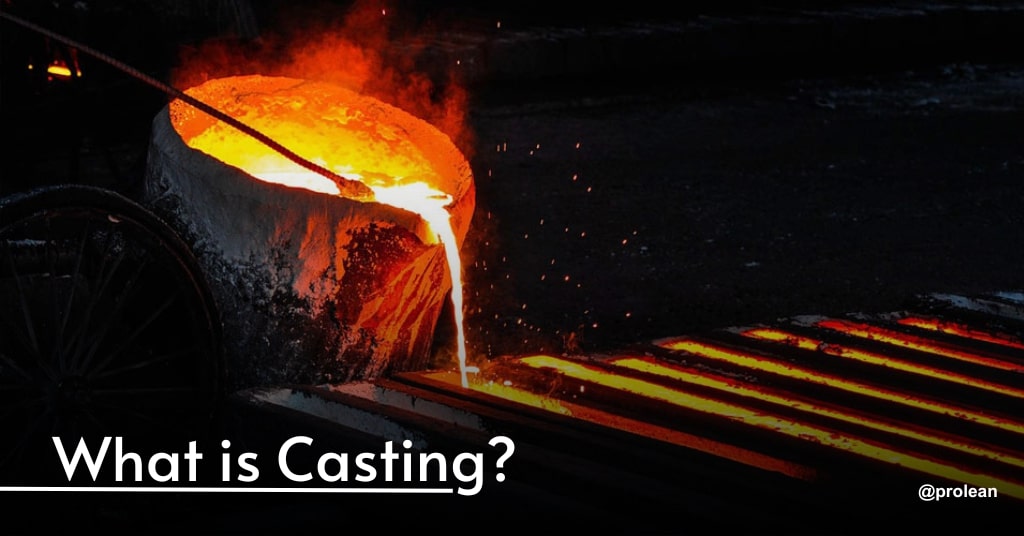
The casting process works efficiently in intricate metal configurations for a wide range of manufacturing industries. It is user-friendly and provides ease for engineers in large production volumes. The die’s efficiency and workability affect the final product design. The negligibility of minor casting defects in dies can deteriorate the manufacturing component quality.
Therefore, while working with the die produced by CNC machining, there are greater chances to achieve perfection. The compatibility of different materials and flexibility in designing have refashioned the overall casting process.
This comprehensive blog contains key information on the casting manufacturing process, its types, and casting materials used in metal casting molds. Moreover, the consideration of selection techniques along with benefits and demerits.
What is Casting? An Overview
Casting is a basic manufacturing process. In its operation, molten metals are poured into a mold cavity, which then hardens, and forms the desired product upon solidification. Tools and dies play a central role in the casting manufacturing process. Casting uses various die-casting materials including aluminum, iron, copper, zinc, chromium, and magnesium. Moreover, it facilitates the production of multiple products in one single unit.
Try Prolean Now!
Different Types of Casting Processes?
There are several processes to cast metals for shaping desired products. These are;
Sand casting
Sand casting, or sand molded casting employs, nonreusable, silica-based molds to design complex feature components. The technique has been utilized and served industries from ancient times and provides inexpensive and recyclable solutions to manufacturers. It uses cheap materials to perform casting, for instance; concrete, epoxy, and plasters, and to make aggregation to shape molds.
The effectiveness of sand casting lies in its ability to cast even high-temperature profile metals such as; ferrous, non-ferrous, aluminum, copper, and steel.
Metal Die Casting
Dimensional stability and precision are key features of die casting. This fastidious and precision-engineered process involves the feeding of nonferrous metals into reusable molds or dies (coated with lubricants) under high pressure to shape the ultimate desired product.
The process is carried out in two ways; high pressure die casting, and Low Pressure Die Casting depending upon the metal used. whether it has high melting or low melting points. In general, low-pressure casting performs under low-pressure conditions and is suitable for parts that require simple features. High-pressure die casting, on the other hand, is employed for mass manufacturing of complex detailed components.
These dies are typically made of steel and carbides to withstand high thermal conditions. Moreover, these ensure high dimensional stability of the intended product. Thus requires carefulness during the casting process.
Die-casting applications span across several sectors from automotive to aerospace parts manufacturing, and it features intricate geometries. Moreover, die-cast products often yield near the finished surfaces which eliminates the need for further processing.
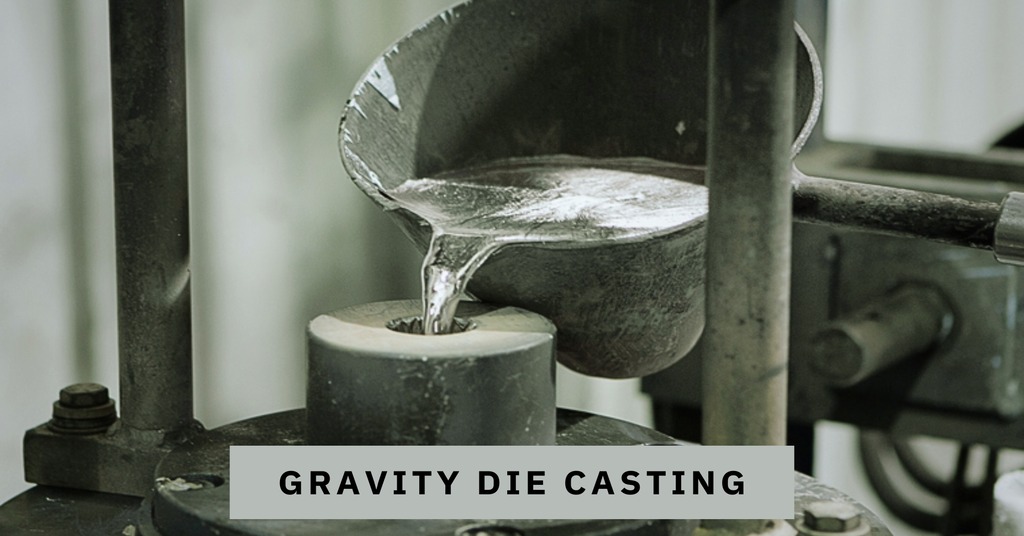
Gravity Die Casting
Gravity die casting is also identified as permanent mold casting. As the name suggests, gravity emphasizes the reliance of casting on gravitational force on which molten alloys are poured into a specified mold or die.
Gravity casting enables the formation of various parts, for instance; enclosures, housing, pipe fittings, engine pistons, car rims, etc. Gravity die casting is applicable for several metals, a few worth mentioning are; zinc, lead, magnesium alloys, and aluminum.
Vacuum Casting
Vacuum casting among the aforementioned techniques is fascinating as it employs standard vacuum conditions. A vacuum is created at a pressure of 100 bars to eliminate or exhaust gases. A red-hot metal is then poured into a mold cavity inside a vacuum chamber to evacuate air pockets and bubbles.
Vacuum casting has a resemblance with the injection molding process as both methods are adaptable for rapid prototyping and feature bubble-free components with low porosity and smooth surface finish. Besides that, it is efficient for small-batch productions. Moreover, it facilitates numerous resins for casting and is applicable to manufacture structural chassis components for automotive and aerospace industries.
Investment Casting
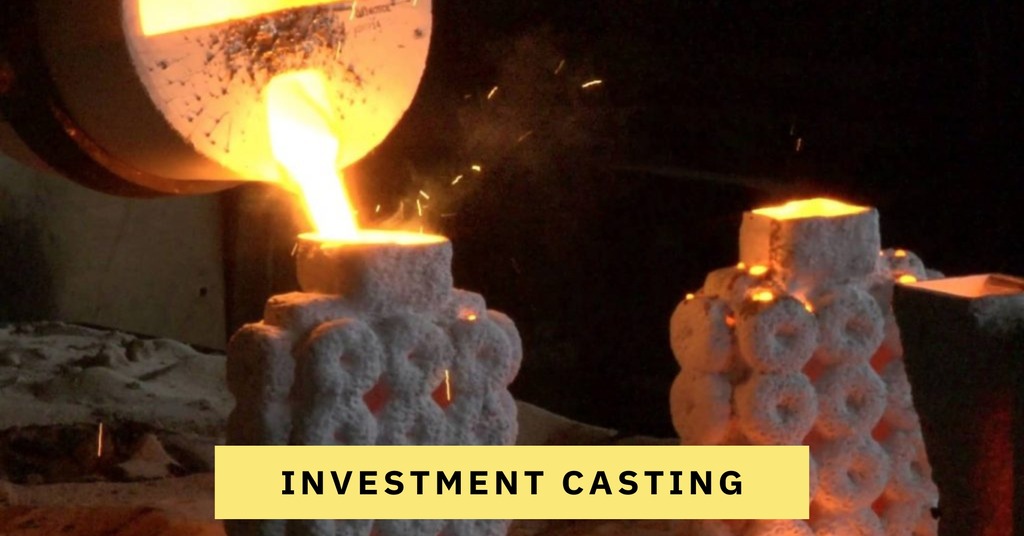
Investment Casting
Investment casting is predominantly used to create complex feature components. In its operation, a wax pattern of the mold is curated and surrounded with a refractory material that serves as sheathing for molten metals like aluminum, and stainless steel.
Although, investment casting is engineered precision for shaping highly detailed feature geometries, it often comes at great expense as it is a labor-intensive process. It features undercuts, thin walls, bicycle trunks, moto discs with high quality, and a near finish. For more information, see our guide on investment casting.
Low pressure die casting, as the term suggests, pours down the molten red metal into a mold cavity at lower pressure up to 0.8 bars, or 100 kPa depending upon the material involved. The process significantly enhances the quality, through continuous controlled filling of the die cavity to eliminate the risks of shrinking and slag formation.
LPDC meticulously shapes contours in thin-walled components by ensuring a smooth finish in short turnarounds. Some common examples include; brake calipers, suspension cases, engine blocks, and cylindrical heads.
Squeeze Casting
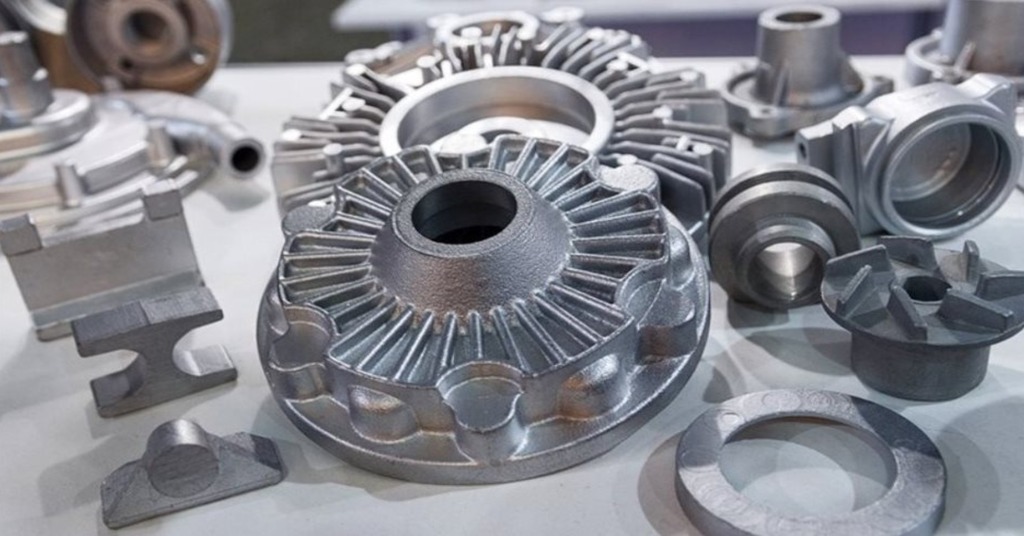
Squeeze Casting Products
Squeeze casting dictates a combined process of die casting and metal forging. It involves the feeding of molten metal into a closed die similar to low pressure or gravity casting techniques.
After injection, the hydraulic press applies high pressure to form a metal forged part. Squeeze casting benefits manufacturers by producing pores and crack-free metal cast products. In the automotive sector, it is exploited to form safety products, for instance, chassis frames, brackets, nodes, and space frame joints. For more information, see our guide on squeeze casting.
Centrifugal Casting
Centrifugal casting, also titled roto casting. It helps to form cast metal parts with minimum voids. In operation, molten metal like magnesium, aluminum, zinc, or lead is spewed in a reusable mold or a spinning die, at high pressure to produce cylindrical components or asymmetrical components. For example; engine pistons, gears, pipe fittings, and gear housings.
Lost Foam Casting
Lost foam casting has some similarities, the only difference is that foam casting uses foam, whereas, investment casting uses wax.
In its process, the foam is injected into a mold coated with styrene as a refractory material. Various metals are compatible with this technique, such as ferrous alloys, cast iron, and carbon steel. In addition to applications, this process has a significant role in automotive, aerospace, defense, and arts, to form a broad range of metal cast parts. For instance; fire hydrants, walls, and pump enclosures are usually made out of this casting technique.
Plaster Casting
Plaster casting or, plaster mold casting, process uses a mixture of strengthening compounds like gypsum and additives to craft a mold. The additives serve as adhesions that provoke stickiness against the mold. It uses plaster to cast a mold instead of a refractory material. After pouring and setting the plaster, it is eventually removed, allowing the molten metal to pour into the die cavity. Plaster casting benefits various sectors such as jewelry, automobiles, art, sculpture, and aerospace.
Try Prolean Now!
Compatible Metals For Casting Process
Here are the common metals used in casting for various industrial applications.
Aluminum
Aluminum can be investment cast, die-cast, permanent mold, and sand cast for its high mechanical properties, fluidity, and reflective index. From the automotive to aerospace sectors, aluminum casting products are extensively found everywhere. For instance; aluminum is widely used for auto car wheels & interiors, windows, and doors for its lightweight nature, and stringent durability. Moreover, product designers can benefit from aluminum for its ease of manufacturability.
Magnesium
Casting products demand high strength-to-weight ratios and lightweight features for casting products. Here magnesium steps in. Magnesium is strong, rigid, and has EMI and RFI properties of shielding. That makes it sound for electrical connectors, housing, and enclosures. Additionally, it’s an ideal choice for casting when durability is essential for the product. Some of the most common alloys for casting include; AZ91D. For more information, see our comprehensive guide on magnesium die casting.
Zinc
Zinc is abundantly used in metal casting for its ease of machining, good dimensional stability, and flow characteristics. Moreover, it offers high precision with lower tooling costs than other casting metals. One of the standout features of zinc is that its cast products possess high finishing. Zinc is used for casting intricately shaped, and thin wall components. Its applications are so widespread across automotive, aerospace, and consumer products.
Copper
This material offers multiple features including corrosion resistance and high electrical & thermal conductivity. Two of the best copper alloys bronze and brass have huge utility potential in sand casting, high-pressure die-casting, and Co2 casting. Different musical apparatus for instance trombones, trumpets, and horns are made as a result.
Iron
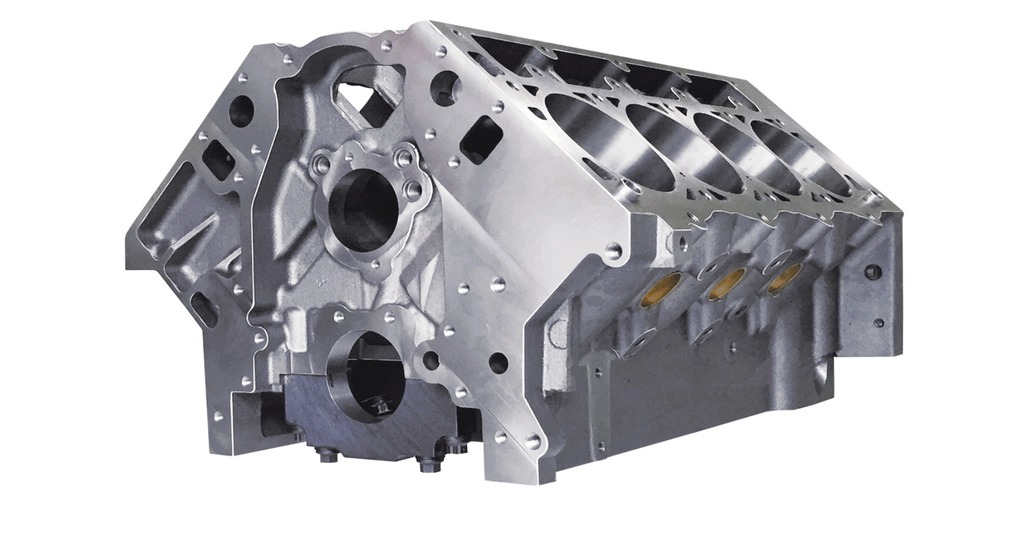
Cast Iron Engine Block
Iron possesses good castability. It has a high resistance to wear and tear and indentation with superior damping capacity. Iron cast products are obtained by combining iron and carbon. Numerous forms of iron are of great use for casting products for instance; cast iron, gray iron, malleable iron, and ductile iron. Some common use applications include; engine blocks, pipes, and automobile parts.
Steel
Steel is a frequently used alloy in casting applications. Among steel alloys, stainless steel is primarily used for casting. It often comes with various benefits in the form of high strength, wear, and impact resistance. One of the key benefits of exploiting steel in casting lies in its ability to withstand harsh environmental conditions. For that reason, it is employed in heavy-duty components such as; construction equipment, forging presses, mining machinery, turbocharger turbines, and engine cylinder blocks.
Lead
Lead is usually employed with its antimony alloys for casting. Most commonly used are antimony 1%, 2%, 3%, 6%. Lead alloys embody distinct features when it comes to casting, for instance, low melting points with incompatible malleability. Lead molded products are used in certain industrial applications, for instance; battery manufacturing, and radiation shielding.
What are The Benefits of the Casting Process?
There are certain benefits of employing the casting process in your projects. For instance, when cost effectiveness, time, designing intricate feature components, and recyclability are critical aspects to consider. Here are some of the most common benefits of employing casting in your projects.
- Metal casting is considerably a speedy metal-forming process.
- The casting is an economical process and brings cost-effectiveness when employed for different materials.
- The use of CNC machining in casting exhibits versatility in the casting process of different materials.
- It offers affordable tooling concerning conventional casting methods.
- The products manufactured from metal casting are lightweight, which is a major requirement of the automotive and aerospace industry.
- Metal casting is an effective way to achieve complex product geometries such as creating engine and cylindrical cavities.
What are The Disadvantages of Casting?
Alongside, the process has a few limitations given below:
- The casting products often need additional processing to refine the product which imparts an additional cost to the process.
- To avoid porosity, shrinkage, warping, and maintaining dimensional stability of casting products comes with certain challenges.
- The casting manufacturing is a labor intensive process.
- The tooling, fixtures, and molds are slightly expensive and pose extra charges to the budget.
- The casting is limited to metals with lower melting points.
- Preparation of wax, and designing molds for casting manufacturing is time-consuming, and leads to high initial investments.
Key Consideration For Selecting a Casting Manufacturing Process
First, we have to understand the importance of the decision-making process. It’s been highlighted by the technical research that inaccurately in casting manufacturing material selection can severely impact the 70 to 80 percent cost of the manufactured product.
Therefore, much emphasis should be placed on critical components including material selection, tolerance level, sizes, shapes, compatible alloys, and last but not least the casting process.
Material Selection
The material selection depends upon the final product specification and requirements. Every workable material in casting has its usage and benefits. The key features of material such as strength, tolerance, energy consumption, and post-manufacturing modifications must be considered while appropriating the casting process.
Required Quantity
Casting is considered an economical process when producing large production volumes. Shorter lead times alongside high batch volume and complex geometrical achievements are the key features of this process.
Cast Surface Finish
The desired gloss and surface finish also influences the selection criteria. Investment casting offers fascinating surface finishes by maintaining material integrity. Die casting, on the other hand, gives high dimensional accuracies with low surface gloss. So, post processing needed to enhance their surface features.
Tolerance Requirements
During the casting process, the nominal dimensions are critical to achieve rather than normal tolerance. These tolerances are generally called “as cast” tolerances. Typically, these depend upon part specifications or geometry, and the metal type being used for casting.
Cost
From initial design to final finishing, and shipping, costs remain the major concerns for casting manufacturing. Therefore, a deep knowledge of the process can help to optimize the casting process. These costs are majorly linked with, alloys, tooling, part complexity, and intended volume to manufacture.
Try Prolean Now!
Get Premium Quality Die Casting Services at Prolean
We are dedicated to providing excellent and affordable die-casting services. Here, at prolean, our engineers will focus on technical details to ensure preeminence and, uncompromised quality in your projects.
Moreover, prolean aims to provide you with comprehensive support throughout to make sure casting parts meet stringent quality standards and optimal results. Whether you are looking for intricately detailed oriented components or large columns, we have the facility to meet your needs. So, send us your project for efficient and precise metal prototyping and get a free quote today!
Read more:
- Die Casting Mold: How To Design Die Casting Mold?
- Revolutionizing Die Casting with Xiomis’s Super Large Die Casting Technology
Summing Up
Casting has become an indispensable choice for various sectors, enabling the production of sophisticated shapes, prototypes, thin wall components, and housings for engine parts to medical use products.
Moreover, design manufacturers have flexibility in choosing metals from a diverse range for their respective processes. The technical understanding of key variables like pressure, temperature, and die-casting mold preparation is vital for achieving the best results.
The casting industry is experiencing a surge of advanced innovative techniques. For instance, ATOS 3D Digitizer revolutionized the casting industry by eliminating the laborious need to perform the casting process.
FAQs
Q1. Does casting differ from injection molding?
Yes, casting and injection molding are notably different processes. The casting process involves pouring, especially molten metals in metal casting molds. In contrast, injection molding injects thermoplastic, or thermosetting polymers to shape detailed intricate shapes.
Q2. What are the common issues encountered in the metal casting process?
The commonest issues caused in the casting process are;
- Porosity
- Incomplete fillings
- Cold shuts
- Shrinkage
- Surface defects (cracks, pits, uneven textures)
Q3. How to choose the right casting technique?
The right selection results in an appropriate material, specifying quantity, justifying required tolerance and desired surface finish. These factors contribute to the selection process of the casting method.
Q4. Which industries extensively exploit metal casting?
The automotive, aerospace, fashion, and energy sectors primarily exploit metal casting processes for several use components. Some common examples include; hydrants, couplings, fittings, connectors, valves, brackets, engine parts, etc.
Q5. What dimensional tolerances are achieved by the casting process?
The maximum flexible tolerance achievable by the casting process ranges from, ±0.15 up to 25 mm, and ±0.3 up to 150 mm.
Resource
K.G. Swift, J.D. Booker, (2013), Manufacturing Process Selection Book: Product Development (Second Edition): Retrieved From: Science Direct

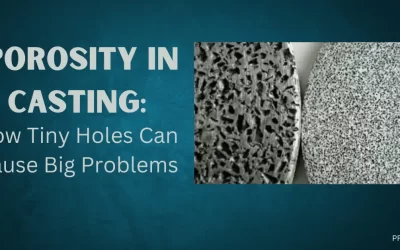
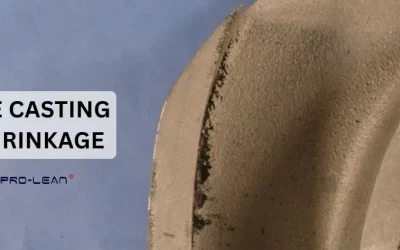
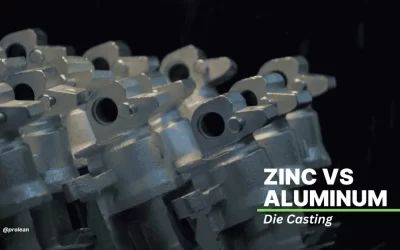
Thanks, especially for that list of metals for casting. It gave me idede to choose the material for my prototyping project.
Indeed, the list was so clear and easy to grap the concept! Thank you